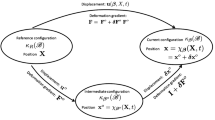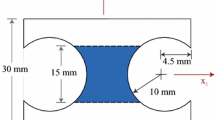Abstract
The identification of nonhomogeneous elastic property distributions has been traditionally achieved with well acknowledged optimization based inverse approaches, but when full-field displacement measurements are available, the virtual fields method (VFM) can be computationally more efficient by converting the large-scale optimization problem into multiple small-scale optimization problems. A possible downside of the VFM so far was not to take into account prior knowledge, which is often available and needed when there is a very large number of unknowns and the inverse problem is ill-posed. In this work, different approaches are proposed for introducing regularization into the VFM, aiming to penalize the local variations of identified stiffness properties in order to reduce the effects of uncertainty in the inverse problem resolution. The feasibility and accuracy of the regularized VFM are tested through several numerical and experimental datasets. It is shown that the main advantage of the novel VFM approaches is the low computational cost, as large-scale inverse problems with 10,000 unknown parameters can be solved within several seconds using a standard personal computer. Although the regularized VFM can successfully detect a stiff inclusion in a soft solid with high accuracy, regularization also introduces unexpected spurious effects in the results, blurring the interface between soft and stiff regions. We also observed that the regularization did not improve the smoothness significantly due to local effects of the small-scale optimization problem introduced in the proposed VFM method. Therefore, traditional regularization, which penalizes local variations of identified stiffness properties, can be combined with the VFM to solve inverse problems with a high computational efficiency, but supplemental regularization conditions will need to be adapted in the future to better delineate soft-stiff interfaces with this methodology.




















Similar content being viewed by others
References
Barbone PE, Rivas CE, Harari I, Albocher U, Oberai AA, Zhang Y (2010) Adjoint-weighted variational formulation for the direct solution of inverse problems of general linear elasticity with full interior data. Int J Numer Methods Eng. https://doi.org/10.1002/nme.2760
Goenezen S, Barbone P, Oberai AA (2011) Solution of the nonlinear elasticity imaging inverse problem: the incompressible case. Comput Methods Appl Mech Eng 200(13–16):1406–1420. https://doi.org/10.1016/j.cma.2010.12.018
Avril S, Huntley JM, Pierron F, Steele DD (2008) 3D Heterogeneous stiffness reconstruction using MRI and the virtual fields method. Exp Mech 48(4):479–494. https://doi.org/10.1007/s11340-008-9128-2
Oberai AA, Gokhale NH, Feijoo GR (2003) Solution of inverse problems in elasticity imaging using the adjoint method. Inverse Probl 19:297–313
Mei Y, Kuznetsov S, Goenezen S (2015) Reduced boundary sensitivity and improved contrast of the regularized inverse problem solution in elasticity. J Appl Mech 83:031001. https://doi.org/10.1115/1.4031937
Dong L et al (2016) Quantitative compression optical coherence elastography as an inverse elasticity problem. IEEE J Sel Top Quantum Electron 22(3):6802211
Mei Y et al (2018) A comparative study of two constitutive models within an inverse approach to determine the spatial stiffness distribution in soft materials. Int J Mech Sci 140:446–454. https://doi.org/10.1016/j.ijmecsci.2018.03.004
Goenezen S et al (2012) Linear and nonlinear elastic modulus imaging: an application to breast cancer diagnosis. IEEE Trans Med Imaging 31(8):1628–1637. https://doi.org/10.1109/TMI.2012.2201497
Bonnet M, Constantinescu A (2008) Inverse problems in elasticity. Inverse Probl 21:R1
Avril S et al (2008) Overview of identification methods of mechanical parameters based on full-field measurements, pp 381–402. https://doi.org/10.1007/s11340-008-9148-y
Zhu Y, Hall TJ, Jiang J (2003) A finite-element approach for Young’s modulus reconstruction. IEEE Trans Med Imaging 22(7):890–901. https://doi.org/10.1109/TMI.2003.815065
Pan X, Liu K, Bai J, Luo J (2014) A regularization-free elasticity reconstruction method for ultrasound elastography with freehand scan. Biomed Eng Online 13(1):132. https://doi.org/10.1186/1475-925X-13-132
Pierron F, Grédiac M (2012) The virtual fields method: extracting constitutive mechanical parameters from full-field deformation measurements. Springer, Berlin
Pierron F, Vert G, Burguete R, Avril S, Rotinat R, Wisnom MR (2007) Identification of the orthotropic elastic stiffnesses of composites with the virtual fields method: sensitivity study and experimental validation, pp 250–259
Avril S, Grédiac M, Pierron F (2004) Sensitivity of the virtual fields method to noisy data. Comput Mech. https://doi.org/10.1007/s00466-004-0589-6
Marek A, Davis FM, Pierron F (2017) Sensitivity-based virtual fields for the non-linear virtual fields method. Comput Mech 60(3):409–431. https://doi.org/10.1007/s00466-017-1411-6
Bersi MR, Bellini C, Humphrey JD, Avril S (2018) Local variations in material and structural properties characterize murine thoracic aortic aneurysm mechanics. Biomech Model Mechanobiol. https://doi.org/10.1007/s10237-018-1077-9
Pierron F, Avril S, Tran VT (2010) Extension of the virtual fields method to elasto-plastic material identification with cyclic loads and kinematic hardening. Int J Solids Struct 47(22–23):2993–3010. https://doi.org/10.1016/j.ijsolstr.2010.06.022
Martins JMP, Andrade-Campos A, Thuillier S (2018) Comparison of inverse identification strategies for constitutive mechanical models using full-field measurements. Int J Mech Sci 145(February):330–345. https://doi.org/10.1016/j.ijmecsci.2018.07.013
Nguyen TT, Huntley JM, Ashcroft IA, Ruiz PD, Pierron F (2017) A Fourier-series-based virtual fields method for the identification of three-dimensional stiffness distributions and its application to incompressible materials. Strain 53:12229. https://doi.org/10.1111/str.12229
Bersi MR et al (2020) Multimodality imaging-based characterization of regional material properties in a murine model of aortic dissection. Sci Rep 10(1):1–23. https://doi.org/10.1038/s41598-020-65624-7
Bersi MR, Bellini C, Di Achille P, Humphrey JD, Genovese K, Avril S (2016) Novel methodology for characterizing regional variations in the material properties of murine aortas. J Biomech Eng. https://doi.org/10.1115/1.4033674
Mei Y, Avril S (2019) On improving the accuracy of nonhomogeneous shear modulus identification in incompressible elasticity using the virtual fields method. Int J Solids Struct 179:136–144. https://doi.org/10.1016/j.ijsolstr.2019.06.025
Mei Y, Tajderi M, Goenezen S (2017) Regularizing biomechanical maps for partially known material properties. Int J Appl Mech 9(2):1750020. https://doi.org/10.1142/S175882511750020X
Shapiro LG, Stockman GC (2001) Computer vision. Prentice Hall, Upper Saddle River
Haddad RA, Akansu AN (1991) A class of fast Gaussian binomial filters for speech and image processing. IEEE Trans Acoust 39:723–727
Huang TS, Yang GJ, Tang GY (1979) A fast two-dimensional median filtering algorithm. IEEE Trans Acoust 27(1):13–18
Liu Z, Sun Y, Deng J, Zhao D (2020) A comparative study of direct and iterative inversion approaches to determine the spatial shear modulus distribution of elastic solids. Int J Appl Mech 11(10):1–17. https://doi.org/10.1142/S1758825119500972
Goldstein T, Osher S (2009) The split Bregman method for L1-regularized problems. SIAM J Imaging Sci 2(2):323–343. https://doi.org/10.1137/080725891
Yoon S, Ioannis G, Siviour CR (2015) Application of the virtual fields method to the uniaxial behavior of rubbers at medium strain rates. Int J Solids Struct 69–70:553–568. https://doi.org/10.1016/j.ijsolstr.2015.04.017
Pierron F (2010) Identification of Poisson’s ratios of standard and auxetic low-density polymeric foams from full-field measurements. J Strain Anal 45:233–253. https://doi.org/10.1243/03093247JSA613
Pierron RMF, Wisnom SRHMR (2011) Full-field strain measurement and identification of composites moduli at high strain rate with the virtual fields method. Exp Mech 51:509–536. https://doi.org/10.1007/s11340-010-9433-4
Acknowledgements
The authors acknowledge the support from the Foundation for Innovative Research Groups of the National Natural Science Foundation (11821202), the National Natural Science Foundation (11732004,12002075), Program for Changjiang Scholars, Innovative Research Team in University (PCSIRT), 111 Project (B14013), the Fundamental Research Funds for the Central Universities (Grant No. DUT19RC(3)017) and the European Research Council for Grant ERC-2014-CoG BIOLOCHANICS. We also thank Prof. Jianwen Luo from Tsinghua University for sharing the experimental datasets.
Author information
Authors and Affiliations
Corresponding author
Additional information
Publisher's Note
Springer Nature remains neutral with regard to jurisdictional claims in published maps and institutional affiliations'.
Appendix
Appendix
Without loss of generality, a discretized two-dimensional domain is considered and two neighboring elements A and B are arbitrarily selected for analysis as shown in Fig. 21a. The corresponding values of Young’s modulus for element A and B are set to \(E_{A}\) and \(E_{B}\), respectively. A local coordinate system is introduced where the directions of the two coordinate axes s and t are along the interface between these two neighboring elements and perpendicular to it, respectively. The relationship between the s-t coordinates and Cartesian coordinates is shown in Fig. 21b. The local coordinates are defined as the axes obtained by rotating the Cartesian coordinates by an angle θ. As the material property distribution is discontinuous in the domain of interest, the material properties are assumed to be constant over every element to preserve the discontinuous transition well. In this case, Young’s modulus does not vary along the interface, i.e. \(\partial E/\partial s = 0\). Therefore, the Young’s modulus depends only on the variable t. Recall the continuous form of the TVD regularization formulation can be expressed as:
According to the rules of coordinate transformation, Eq. (19) can be rewritten in terms of s and t, which is:
To satisfy Eq. (20), the condition, \(\partial E/\partial s = 0\), is utilized. And based upon jump conditions, the TVD formulation can be further reduced to:
where lAB is the length of the interface between the element A and B. It can be seen in Eq. (21) that the discrete TVD regularization is linearly proportional to the difference in the shear modulus between neighboring elements and the length of the interface. So the regularization term reduces to just Eq. (21) since element-wise constant distribution of the shear modulus is assumed.
Rights and permissions
About this article
Cite this article
Mei, Y., Deng, J., Guo, X. et al. Introducing regularization into the virtual fields method (VFM) to identify nonhomogeneous elastic property distributions. Comput Mech 67, 1581–1599 (2021). https://doi.org/10.1007/s00466-021-02007-3
Received:
Accepted:
Published:
Issue Date:
DOI: https://doi.org/10.1007/s00466-021-02007-3





